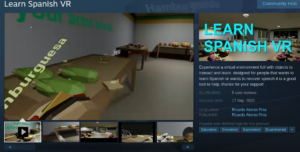Hey, I’m Ricardo Alonso.

When I first stumbled into the world of VR, it reignited an old flame: my passion for video games. This fire burned so hot, I had no choice but to dive headfirst into game development.
My first creation? Pejes Vs Zombies.
 Built using Unreal Engine, this game came to life thanks to their blueprint coding system—no manual coding required, which was a lifesaver! I was hyped, especially since I had some Blender experience with 3D objects and textures, but it all started to click when I began building this game. Inspired by Mexican culture, Peje is a character based on none other than Mexico’s president, Andrés Manuel López Obrador. His nemesis? Chente, modeled after Vicente Fox Quezada. You can choose from various colorful versions of both.
Built using Unreal Engine, this game came to life thanks to their blueprint coding system—no manual coding required, which was a lifesaver! I was hyped, especially since I had some Blender experience with 3D objects and textures, but it all started to click when I began building this game. Inspired by Mexican culture, Peje is a character based on none other than Mexico’s president, Andrés Manuel López Obrador. His nemesis? Chente, modeled after Vicente Fox Quezada. You can choose from various colorful versions of both.
The game mechanics? Borrowed from a template I snagged, but all the level design? That was me, piecing together objects from everywhere. My own creations were the 3D models of the characters, the level design, and a few key items—especially the ones in the Masonic Lodge (which, fun fact, made their way into another game I launched later).
But releasing the game was no walk in the park. My first attempt? A total mess—bugs everywhere, everything falling apart. After some intense bug-hunting sessions and countless fixes, I finally got the green light from Steam. They gave me a hard time with all their requirements, but hey, it’s understandable—they only want top-notch games on their platform.
This game was my baby. It taught me so much—not just about game development, but about every aspect of it, including sound production.
Another game I released is Illuminati Simulator VR.
I built this one to dive deep into the mechanics of VR and see just how far I could push the boundaries. In this game, you step into a Masonic lodge—and if you’re not familiar with the Masons, let me tell you, these places aren’t just thrown together randomly. They follow strict blueprints, with each room serving a purpose steeped in symbolism and tradition.
As you explore, you’ll even find a Gnostic Mass happening inside. But here’s where things get really interesting: the game is packed with hidden rituals. If you interact with certain objects in the right way, you’ll unlock secrets.
For example, during the Gnostic Mass, you’ll find a magic wand. Use it right—perform the Red Ruby Ritual—and boom, you’ll open a portal. In the Masonic Lodge, there are objects with secret “gesture tracking” mechanics—figure out the correct moves, and you’re in for a surprise.
At its core, this simulator is about unveiling a deep, mysterious secret—one tied to “the ultimate truth.”
The game features open-source mechanics, allowing characters to grab objects, drive, climb, shoot, and more. As for the level design, it’s a mix of marketplace assets and original creations—especially inside the Masonic lodge. I built the pillars, emblems, carpets, and more, all according to the ancient and accepted Scottish Rite, down to the eerie Chambers of Reflection for each degree.
My latest release is Learn Spanish VR.
And for this one, I wanted to do something completely different. Usually, I use templates or open-source mechanics, but this time, I built everything from the ground up. Every object in the game has its own unique sound when you grab or drop it.
The game’s goal is simple: to teach you Spanish in a fully immersive VR environment. When you grab an object—say, a carrot—the word carrot appears in front of you, and you’ll hear a girl’s voice clearly say “carrot.”(zanahoria in spanish) It’s like the game is teaching you without you even realizing it. Every object works this way, so as you explore and interact with the world, you’re constantly picking up new vocabulary without even thinking about it.


